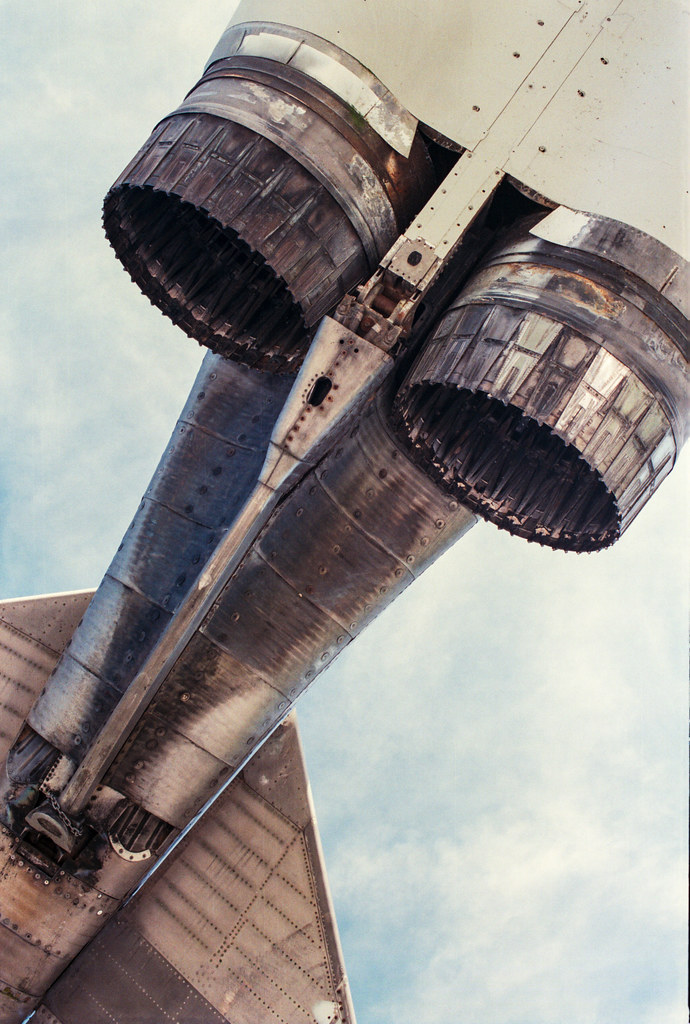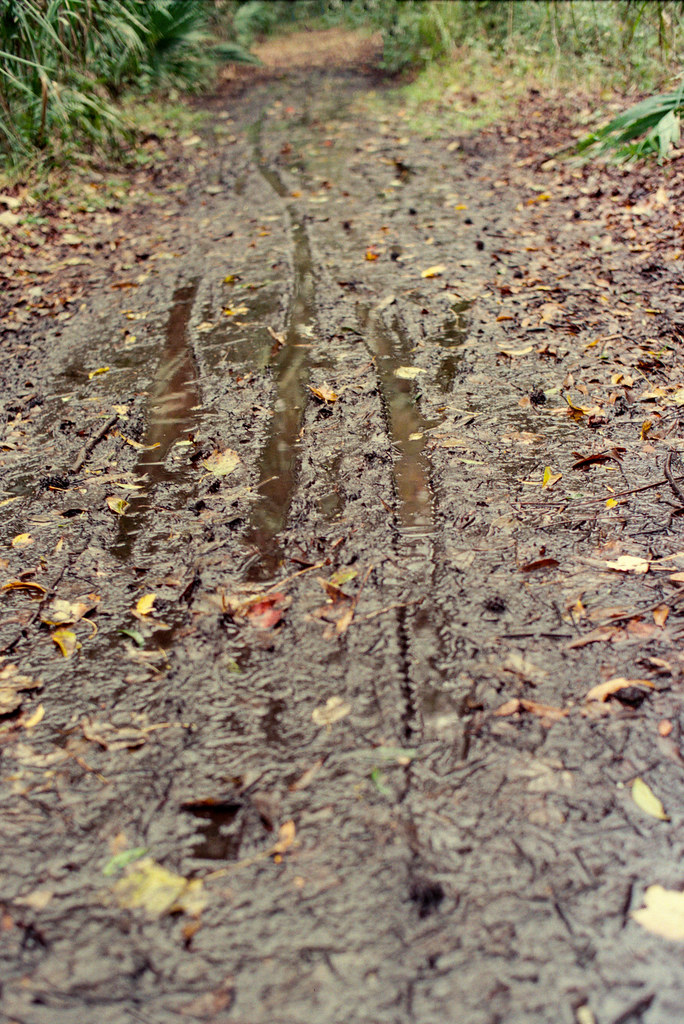 |
| Nikon FT2 with Nikkor 35mm f/2.0 |
The FT2 is available in black and chrome, and the going rate for a working one seems to run about $25 to $35 for the body alone. It's really not a bad price, if you don't mind dealing with some of its quirks (which I'll tell you about). Personally, I found mine locally on Craigslist from a guy who had moved away from film, and he sold me the FT2 along with a Nikkor 35mm f/2.0 (non-Ai) for $70 total. Since the going rate for this lens on eBay is $85 to $100, I figure I basically got the FT2 body for free.
Build and Layout
 |
| The shutter speed selector ring and self-timer switch |
 |
| ISO selection needle |
On the top panel, you have the standard equipment. The film rewind knob, the film advance lever, the shutter release button, and the frame counter. The film rewind knob is pulled up and out of the body to release the film canister, but unlike many cameras, it does not also open the film door. This is instead accomplished by a small tab on the lower edge of the door, on the latch side. The top panel also contains a plunger that acts as a depth of field preview button, and a small metering display. The top panel metering display is one really nice benefit of this camera that isn't seen on many from this time period.
 |
| Rewind knob and meter display |
 |
| Frame counter and film advance lever. Front left: depth of field preview button |
Finally, there's the viewfinder. Like most 35mm SLR viewfinders, it's big and bright. It has the split-image rangefinder spot in the center, with a microprism collar. A wider circle is etched into the screen to show the boundary of the center-weighted area. On the right side you have the meter display, showing a centering needle pointing to + or - on either end, or in the center to indicate correct exposure. At the bottom of the screen is a shutter speed display, with the selected shutter speed in white and the next and previous steps printed in yellow. This display changes with the position of the shutter speed ring, and it's lit by the scene (so don't expect to be able to see it in low light).
The shutter itself is fully mechanical, meaning you can use it without batteries at any speed, as long as you know how to work without the light meter. It's capable of 1 sec to 1/1000 sec, plus bulb, and flash syncs to 1/125. Speeds outside of the flash sync range are printed in red on the selector ring.
The FT2 in Use
Using this camera is a bit weird, I'll admit. It may be a side effect of its age, but while the shutter speed dial does click into place at each stop, it has this weird damping that allows it to move uncomfortably within that click stop. Sometimes you're not sure if you pulled it too far. When you do change the shutter speed, the areas in between speeds cause the meter to blank out until the ring clicks into a stop. Combined with that play in the ring, it means that sometimes I have to wiggle the shutter speed ring around a little to get the meter working. Also, the ISO selection is a bit strange, where you're pulling out on the end of the shutter speed selection lever and simultaneously sliding a small needle to a spot adjacent to your desired speed. Although I do appreciate that it's locked into place, because I could easily see it being bumped to a different setting otherwise.
 Another possible sign of age is the film take-up spool. You need to get the film leader into a slot of the take-up spool, and then rotate it one full turn to ensure that a sprocket hole has snagged on a tooth in that slot. Unfortunately, I have the absolute worst luck with this. It's harder than it is in any other camera that I've ever used, and it sometimes takes me upwards of 5 minutes to get the film seated correctly without popping out of the slot as the spool begins to turn. On the upside, when I do finally get the film loaded, the film advance feels clean and smooth, and requires little effort to move from one frame to the next.
Another possible sign of age is the film take-up spool. You need to get the film leader into a slot of the take-up spool, and then rotate it one full turn to ensure that a sprocket hole has snagged on a tooth in that slot. Unfortunately, I have the absolute worst luck with this. It's harder than it is in any other camera that I've ever used, and it sometimes takes me upwards of 5 minutes to get the film seated correctly without popping out of the slot as the spool begins to turn. On the upside, when I do finally get the film loaded, the film advance feels clean and smooth, and requires little effort to move from one frame to the next.
 Another possible sign of age is the film take-up spool. You need to get the film leader into a slot of the take-up spool, and then rotate it one full turn to ensure that a sprocket hole has snagged on a tooth in that slot. Unfortunately, I have the absolute worst luck with this. It's harder than it is in any other camera that I've ever used, and it sometimes takes me upwards of 5 minutes to get the film seated correctly without popping out of the slot as the spool begins to turn. On the upside, when I do finally get the film loaded, the film advance feels clean and smooth, and requires little effort to move from one frame to the next.
Another possible sign of age is the film take-up spool. You need to get the film leader into a slot of the take-up spool, and then rotate it one full turn to ensure that a sprocket hole has snagged on a tooth in that slot. Unfortunately, I have the absolute worst luck with this. It's harder than it is in any other camera that I've ever used, and it sometimes takes me upwards of 5 minutes to get the film seated correctly without popping out of the slot as the spool begins to turn. On the upside, when I do finally get the film loaded, the film advance feels clean and smooth, and requires little effort to move from one frame to the next. |
| Meter coupling pin |
 |
| Lens attached with meter coupling pin inside "rabbit ears" prong |
 |
| Lens aperture index indicator: red mark indicates an f/2 lens is mounted |
One last strange behavior, which is common to many Nikons, is the fact that the meter is only turned on when the film advance lever is pulled out a step. If the lever is pressed flush against the body (as it normally would be with any other camera manufacturer), the meter is disabled. Normally, I wouldn't mind that extra step, because it does help extend battery life. The problem is that I'm left eye dominant, which means that if I want the meter enabled while I'm looking through the viewfinder, the film advance sticks out uncomfortably close to my right eye.
So What's the Word?
 Okay, there are definitely some strange design decisions at work here. But after taking it with me on a trip to California, and then bringing it along on a nice hike in the woods of Central Florida, I've gotten pretty used to its quirks. It really is built to take a beating, and I'm a sucker for fully mechanical shutters, so it gets bonus points for that. It sounds great, and the meter has been surprisingly accurate. The non-Ai body means that you can mount any non-Ai, Ai, or Ai-S lens as long as it has the rabbit ear prongs installed, which is nice (Ai and Ai-S bodies require lens modification to fit non-Ai lenses, making non-Ai bodies the most compatible).
Okay, there are definitely some strange design decisions at work here. But after taking it with me on a trip to California, and then bringing it along on a nice hike in the woods of Central Florida, I've gotten pretty used to its quirks. It really is built to take a beating, and I'm a sucker for fully mechanical shutters, so it gets bonus points for that. It sounds great, and the meter has been surprisingly accurate. The non-Ai body means that you can mount any non-Ai, Ai, or Ai-S lens as long as it has the rabbit ear prongs installed, which is nice (Ai and Ai-S bodies require lens modification to fit non-Ai lenses, making non-Ai bodies the most compatible).
So would I recommend it? I guess it depends. For the money it competes with others from its era, like the Pentax K1000 or Spotmatic II, and I would choose the FT2 in a heartbeat. I have both of those other cameras, and the Nikkormat has a better flash sync speed, has the top mounted meter display, and has the mirror lock-up switch. I also prefer the split-image rangefinder with microprism collar to the microprism-only spot that the other two offer.
If you're looking for a body to mount to your existing non-Ai glass, then this is a no-brainer. It's the last non-Ai model that Nikon made, and has a number of benefits over the older FTn. If you're looking to get started in film photography and you're trying to decide which sub-$50 camera to start with, I can recommend this for that purpose as well. However, if you're willing to put a little more money into the hobby, then there are other options that I would look at instead.
For what it's worth (not much, I'm afraid), I have a Flickr photo album containing photos taken with the FT2 (as well as the photos above of the camera itself). It's updated with new photos from time to time, as I use the camera.
Did I miss anything, or say something stupid? If you have anything to add or questions you'd like answered, feel free to leave a comment!
Did I miss anything, or say something stupid? If you have anything to add or questions you'd like answered, feel free to leave a comment!


Hai Jittery Pixel,
ReplyDeleteReally nice too see your review for the Nikkormat FT2.
I bought the camera today because I want to feel what my parent feel in their era. Your review really help me to operate the camera and yeah you stock photos in Flickr really great.
Thank you
Hi, thank you so much for letting me know you found the review helpful! Enjoy the camera, it’s a lot of fun to use. :)
ReplyDeleteJeff
Hello Jeff, great review. I have 2 Nikkormat FTn’s, both in great shape and bought cheaply off eBay. I just bought an FT2 the other day, good condition with a 50mm f/2 lens, for $60. Looking forward to it’s arrival! Greg
ReplyDeleteHi its not a bad camera picking up a extra one with the lens in there own boxes
ReplyDeleteOne minor correction. The Nikon ELW, introduced in 1976, was the last non-Ai model to be released, though both it and the FT-2 were discontinued in 1977.
ReplyDeleteThe Nikkormat was a wonderful camera. I had a black version bought brand new in the late 70s and used it for many years as my main maritime photography rig.
ReplyDeleteIt took everything ships threw at it, smacking against ladders, bulkheads, hull plating, railings. It also shook off salt air dampness, windblown sand, salt spray and the muck and grime inside floating drydocks.
I only put it in backup service when the meter finally twitched out and died, and the body was so beat up that it was obvious it was not worth saving. It's replacement was a Nikon FE2, which is still a popular camera on the used market. I also wore out the FE2 and it became second nature when using it. As quirky as the Nikkormat was, my FT2 still feels more natural in the hand than the FE2. For me, the Nikkormat is the perfect vintage 35mm camera.
The Nikkormat was and is a rugged and reliable camera. I might even trade in my digital cameras to get more AI-S lenses for it!
I sold these cameras back in the day at a graphic arts/photo store back in the day. I’ve always wanted one and yesterday scored one on FB marketplace from a local seller for $80 including a 50mm f2 AI lens. I think I like it better than my F2! It sounds and feels better and with each release of the shutter, I am transported back to my teenage years, although those years, my “shooting irons” were a Minolta ST101(solid) and XE7(junk).
ReplyDeleteThe camera’s simplicity and with the DOF plunger on the top plate makes for a camera that makes you concentrate on what you are doing and the shutter speed ring on the lens mount is fine because I’m a 125th@F8 kind of guy anyway!
I have been a longtime Nikon fan since the F2 days, and although I used a FM/FE when they were current, today I'd rather use the FT2. If I am going for a nostalgic film experience, I want to be fully immersed, and the FT2 gives me that. I actually love the lens mounting procedure, as it is a real physical/aural treat that does not exist in this digital age. Other benefits of the FT2 is a modern battery (no mercury cells like the FTN) and a really solid build quality, which the later FM/FE lack. Yes it's a little heavy, and I would really like a ratcheting film advance, but it is a great inexpensive way to mount those vintage Nikkors and have fun!
ReplyDelete